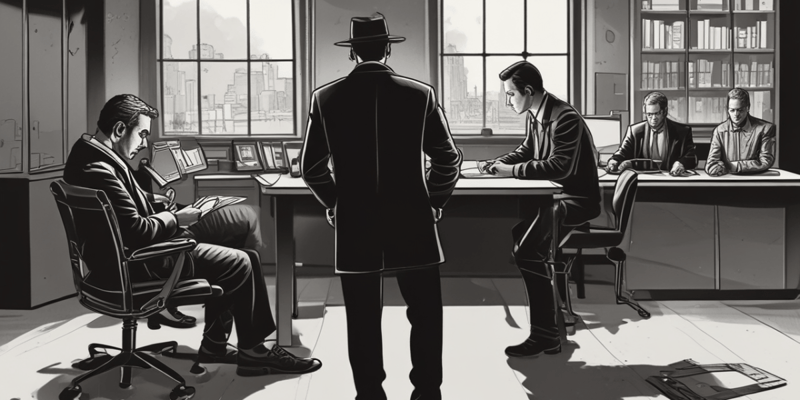38 Questions
Which method did Alphonse Bertillon develop for offender identification?
Anthropometry
What percentage of a criminal investigator's time is estimated to be spent on gathering subjective information?
90%
What did descriptions of offenders form the basis of before the advent of fingerprints as a means of identification?
Police files
Which strategy aims to convince interrogees that the only way out is to confess, because the investigator has convincing evidence of their guilt already?
Single purpose interrogation
What is an example of general information that forms part of PDs?
Names and addresses
What is a major contributing factor to wrongful convictions?
Witness error
Which factor can reduce the accuracy of eyewitness information?
High stress levels
Which theory suggests that the longer the time that passes between observing an event and trying to recall the details of the event, the greater the risk that details will be forgotten?
The physical trace theory
What is the term used to describe the unintended effect of misinformation from external sources that lead to the creation of false memories in a witness through details picked up from other witnesses, newspapers, the criminal investigator or other sources?
Suggestion
Which factor influences personal perceptions that individuals from a specific race/ethnicity or sex are predominantly responsible for the crime problem?
Prejudice and stereotyping
What is the term used to describe the inadvertent process of filling in the gaps in memory reconstruction with information gleaned from other memories, or general knowledge and assumptions?
Unconscious transference
According to the text, what is the definition of an eyewitness?
A person who personally saw the crime transpire.
According to the text, what is the definition of a corroborative witness?
A person who can provide information about the circumstances which surrounded a crime.
According to the text, what additional evidence would be needed to support the assumption that the person seen running from the tuckshop committed the crime?
Both ballistic testing and gunshot residue testing.
According to the text, what is the purpose of a personal description (PD)?
To provide a verbal description of the physical features of an alleged perpetrator.
Which of the following statements about composite pictures of the face (IdentiKits) is true?
IdentiKits are manual or electronic toolkits used to compile the face of the perpetrator
Which technique is used when questioning a person who is reluctant, unwilling, or hostile to provide information?
Interrogation
What is the main purpose of criminal photograph albums (Rogue's Galleries)?
To provide a point of departure for documenting descriptions of previously convicted criminals
Which of the following is NOT a difference between interviews and interrogations?
Note taking/recording
An eyewitness is a person who personally saw the crime ______.
transpire
A corroborative witness is a person who can provide information about the circumstances which surrounded a ______.
crime
In the case of an eyewitness, the additional evidence is value that is ______.
added
The difficulty to express in words what someone looks like, is ameliorated by the police through using supplementary techniques to assist the witness to ensure that descriptions are as ______ as possible.
accurate
According to the text, what is the definition of unconscious ______?
transference
During memory reconstruction, individuals often inadvertently fill in gaps with information gleaned from other memories; or general knowledge and assumptions - this inadvertent process of filling in the gaps is referred to as ______ ______.
unconscious transference
Unwillingness to co-operate – there are various reasons why persons would not want to cooperate and information received from such persons should be considered with great caution as they may be ______ ______ or vague when providing information.
intentionally deceitful
Factors that relate to ______ ______: Suggestion is the unintended effect of misinformation from external sources that lead to the creation of false memories in a witness through details picked up from other witnesses, newspapers, the criminal investigator or other sources.
human disposition
Composite pictures of the face (IdentiKits) consist of interchangeable graphic representations of basic facial features that are compiled by overlaying the features one at a time until the witness is ______ that the composite picture looks like the person he/she is describing.
satisfied
In a criminal investigation, questioning is a conversation between an interviewer and an interviewee during which questions are asked to obtain information about an alleged crime. Two techniques that may be used during questioning are: (i) Interviewing - ANY PERSON who is ready, willing and qualified to provide information. (ii) Interrogation - ANY PERSON who is ______, unwilling or hostile to provide information.
reluctant
A commonly held belief in criminal investigation is that successful criminal investigators do not interrogate persons who they can rather interview through building ______ with interviewees.
rapport
Interrogations usually take place at a later stage deliberately to give the interrogator enough time to gather as much information as possible. Interrogators determine the ______ to their advantage.
place
Alphonse Bertillon is considered the founder of personal descriptions as a means of identification in criminal investigations. Bertillon used Quetelet’s supposition of uniqueness, which posits that no person has exactly the same measurements and sizes across their body, to develop the anthropometric method of identification, or anthropometry, as a method of offender identification. Bertillon’s method was called the Bertillonage, and entailed the measurement of eleven key points of the body (e.g. the length and breadth of the head and the distance between elbow joint and fingertip), plus a description of the perpetrator’s eye, hair and skin colour. Bertillon calculated the odds of two persons having the same description and measurements as being ______.
4 194 304:1
Subjective information is gathered from people in a criminal investigation by talking to them and posing questions. It is estimated that the vast majority of a criminal investigator’s time (up to 90%) is spent on gathering, processing and evaluating ______ information.
subjective
Without the cooperation of people who have information about a crime that was committed, the criminal investigator can barely ______.
function
Factors that relate to HUMAN ABILITY: (a) First, perceptivity (or individuals’ ability to observe with accuracy) may be influenced by: Eyesight - short sightedness, far sightedness, and colour blindness can influence the detail with which witnesses are able to produce eyewitness information. Surrounding circumstances - the time of day and the quality of light when a crime is witnessed, distance from which a crime incident is witnessed, and distractions like loud noise and a large crowd of people being present when a crime was witnessed can increase the difficulty of describing and identifying the perpetrator. Exposure duration - the longer the witness is exposed to the perpetrator, the more accurate the identification. Emotional condition - consider for example the impact of fear, shock and anxiety which typically accompany witnessing a crime. Research has confirmed that high stress levels drastically reduce the accuracy of eyewitness information. Individuals tend to recall information best under conditions of moderate stress/arousal. 14 The so-called weapon-focus effect is related to this, where the presence of a weapon draws the witnesses’ attention away from the perpetrator’s appearance to the weapon. Previous experience – being a witness in a criminal investigation on more than one occasion may contribute to better descriptions because the witness knows what to expect. Alcohol and/or drug intoxication can impair attention, perception, thought, memory and judgement. Mental health – e.g. a person diagnosed with paranoid schizophrenia experiences hallucinations and delusions which blur the lines between what is real and may find it difficult to provide a reliable description of events. (b) Second, a person’s memory (ability to recall events) is also linked to human ability: What is important to consider is that human memory is not a transcript or video-like record.
real and reliable
When dealing with information retrieved from witnesses, one should therefore be aware that humans are fallible, regardless of their good intentions in wanting to assist with information in a criminal investigation. Factors that can adversely affect the reliability of witness information can broadly be divided into the following (please note the structuring of the factors under appropriate headings): 13 (i) Factors that relate to HUMAN ABILITY: (a) First, perceptivity (or individuals’ ability to observe with accuracy) may be influenced by: Eyesight - short sightedness, far sightedness, and colour blindness can influence the detail with which witnesses are able to produce eyewitness information. Surrounding circumstances - the time of day and the quality of light when a crime is witnessed, distance from which a crime incident is witnessed, and distractions like loud noise and a large crowd of people being present when a crime was witnessed can increase the difficulty of describing and identifying the perpetrator. Exposure duration - the longer the witness is exposed to the perpetrator, the more accurate the identification. Emotional condition - consider for example the impact of fear, shock and anxiety which typically accompany witnessing a crime. Research has confirmed that high stress levels drastically reduce the accuracy of eyewitness information. Individuals tend to recall information best under conditions of moderate stress/arousal. 14 The so-called weapon-focus effect is related to this, where the presence of a weapon draws the witnesses’ attention away from the perpetrator’s appearance to the weapon. Previous experience – being a witness in a criminal investigation on more than one occasion may contribute to better descriptions because the witness knows what to expect. Alcohol and/or drug intoxication can impair attention, perception, thought, memory and judgement. Mental health – e.g. a person diagnosed with paranoid schizophrenia experiences hallucinations and delusions which blur the lines between what is real and may find it difficult to provide a reliable description of events. (b) Second, a person’s memory (ability to recall events) is also linked to human ability: What is important to consider is that human memory is not a transcript or video-like record.
fallible and impaired
Eyewitnesses are often critical sources of information to determine what happened during a crime. Although playing a central role in criminal investigations and decision-making, eyewitness information has often been found to be unreliable, and constitutes a major contributing factor to wrongful convictions. It is estimated that up to 75% of false convictions are caused by witness error. False convictions are sometimes due to a witness’ deliberate lies about the crime. However, it should be noted that in the vast majority of cases witness error is unintentional, with no malice intended.
unreliable and unintentional
Unwillingness to co-operate – there are various reasons why persons would not want to cooperate and information received from such persons should be considered with great caution as they may be ______ false or vague when providing information.
deliberately
Test your knowledge on criminal photograph albums and police sketches in this quiz. Learn about the use of rogue's galleries and how they help identify similar facial features in previously convicted criminals. See how police artists create sketches based on descriptions provided. Can you score 8/8 on this quiz?
Make Your Own Quizzes and Flashcards
Convert your notes into interactive study material.




